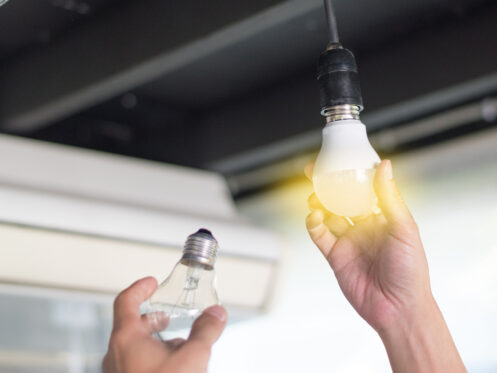Choosing the right LED bulbs for your home can significantly reduce the amount of electricity that your home uses. To help you select the right bulbs, we put together a helpful guide on LED bulbs and energy efficiency.
Understanding LED Bulbs
LED bulbs use a semiconductor to produce light, making them highly energy-efficient compared to traditional incandescent and CFL bulbs. They work by passing an electric current through a microchip, which illuminates tiny light-emitting diodes. LED bulbs offer several advantages over traditional bulbs. They consume less energy, last significantly longer and emit less heat. LED bulbs are also more durable and resistant to shock and vibration. However, there are some common misconceptions about LED bulbs, including concerns about their initial cost and light quality. In reality, LED technology has advanced to provide a wide range of color temperatures and brightness levels.
Factors to Consider When Choosing LED Bulbs
When selecting LED bulbs, consider factors such as brightness and color temperature, which affect the ambiance and functionality of a space. Look for bulbs with the right wattage equivalent and lumens to achieve the desired brightness. Ensure dimmability and compatibility with fixtures, especially if you plan to use dimmer switches. You should also consider the lifespan and warranty of LED bulbs to gauge their longevity and reliability.
Energy Efficiency Ratings
Look for Energy Star-certified LED bulbs that meet strict energy efficiency guidelines set by the Environmental Protection Agency. Energy Star certification signifies superior energy performance and can help you save on energy costs over time. Additionally, pay attention to energy efficiency labels and standards to ensure that your chosen LED bulbs meet industry benchmarks for efficiency and quality.
Cost Considerations
Even though LED bulbs may have a higher upfront cost compared to traditional bulbs, they offer significant long-term savings due to their energy efficiency and durability. This is why it’s pertinent to calculate the return on investment of LED bulbs based on their energy savings and lifespan. Homeowners can sometimes save money by opting for budget-friendly options and promotions offered by manufacturers or retailers.
Environmental Impact
LED bulbs contribute to environmental sustainability by reducing energy consumption and carbon emissions. Their long lifespan means fewer bulbs end up in landfills, reducing waste. When disposing of LED bulbs, look for recycling programs to ensure proper disposal.
Practical Tips for Purchasing and Using LED Bulbs
To prevent compatibility concerns, make sure the LED bulbs you choose are the right size for your fixtures. Take into account the placement and distribution of lights in your house to get the best lighting effects. If you have smart home systems or unique light fixtures, be sure the new system will work with them.
Can You Use LED Bulbs Outdoors and in Damp Environments?
Yes, you can use LED bulbs outdoors and in damp environments, but it’s essential to choose bulbs specifically designed for these conditions. Look for LED bulbs labeled “outdoor-rated” or “damp-rated” to ensure they can withstand exposure to moisture and varying temperatures without compromising performance or safety. Sealing outdoor LED bulbs prevents water and dust infiltration, making them perfect for gardens, patios and other outside locations.
How Do I Determine the Wattage Equivalent of an LED Bulb?
To determine the wattage equivalent of an LED bulb, you should consider its lumen output rather than its wattage. Lumen output measures the brightness of the bulb, while wattage indicates the amount of power consumed. LED bulb packaging often includes information on the lumen output and wattage equivalent to help consumers make comparisons to traditional incandescent bulbs. As a general guide, a 10-watt LED bulb typically provides the same brightness as a 60-watt incandescent bulb. However, this can vary depending on factors such as color temperature and bulb design.
Are There Any Special Considerations for Using LED Bulbs in High-Ceiling Areas?
When using LED bulbs in high-ceiling areas, consider factors such as beam angle and color temperature to ensure optimal illumination and energy efficiency. Choose LED bulbs with a wide beam angle to distribute light evenly across large spaces and select color temperatures that complement the intended use of the area. To minimize flickering and compatibility difficulties, make sure the LED lights are compatible with high-ceiling dimming systems and controllers.
When Forest Lake, MN, homeowners need help with electrical or lighting installations, it’s best to call Plugz Electric. To schedule an LED lighting consultation for your home, contact us now.



